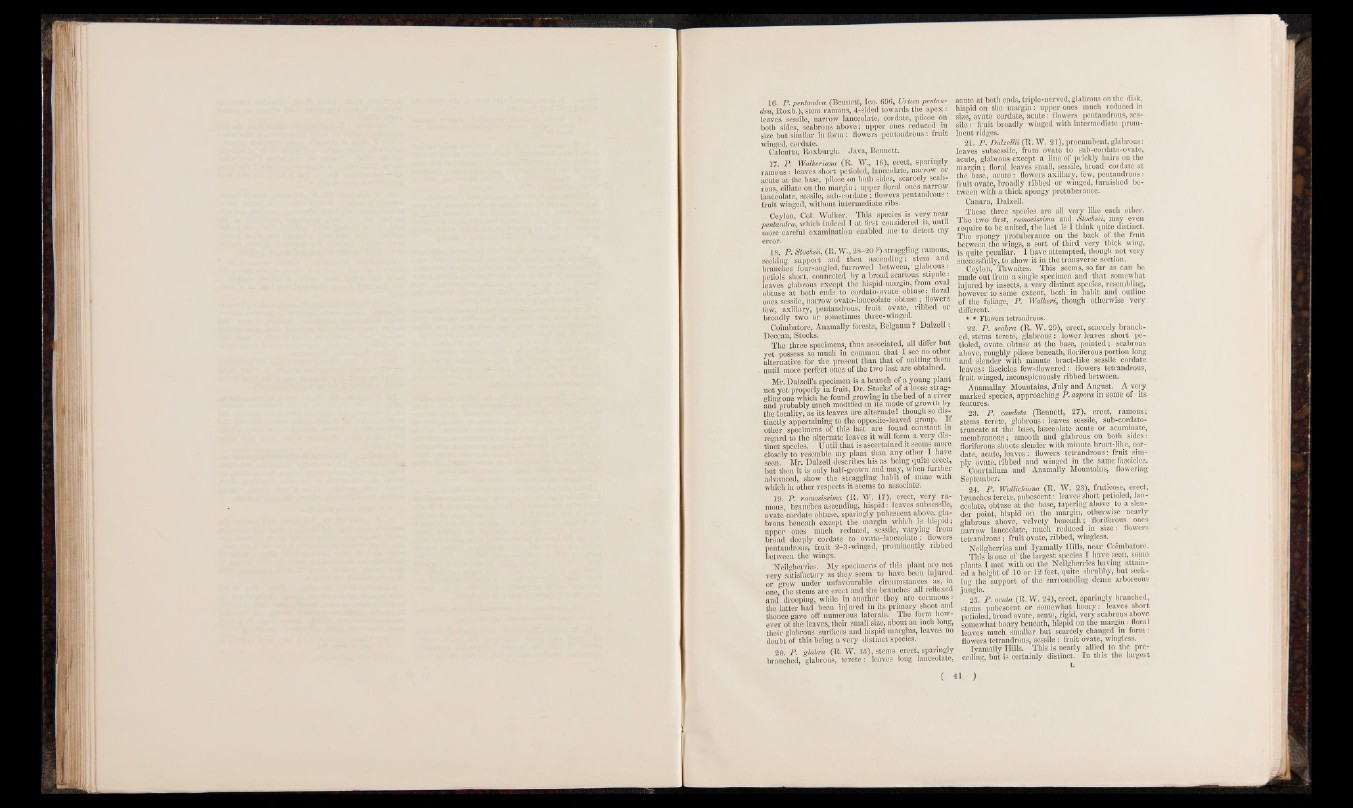
16. P. pentandra (Bennett, Ico. 696, Urtica pentandra,
Roxb.), stem ramous, 4-sided towards the ap e x :
leaves sessile, narrow lanceolate, cordate, pilose on
both sides, scabrous above; upper ones reduced iii
size but similar in form : flowers pentandrous: fruit
winged, cordate.
Calcutta, Roxburgh. Java, Bennett.
17. P. Walkeriana (R. W., 16), erect, sparingly
ramous: leaves short petioled, lanceolate, narrow or
acute at the base, pilose on both sides, scarcely scabrous,
ciliate on the margin; upper floral ones narrow
lanceolate, sessile, sub-cordate : flowers pentandrous:
fruit winged, without intermediate ribs.
Ceylon, Col. Walker. This species is very near
pentandra, which indeed I at first considered it, until
more careful examination enabled me to detect my
error.
18. P. Stocksii, (R. W., 28-20 ?) straggling ramous,
seeking support and then ascending; stem and
branches four-angled, furrowed between, glabrous :
petiols short, connected by a broad scarious stipule:
leaves glabrous except the hispid margin, from oval
obtuse at both ends to cordato-ovate obtuse; floral
ones sessile, narrow ovato-lanceolate obtuse ; flowers
few, axillary, pentandrous, fruit ovate, ribbed or
broadly two or sometimes three-winged.
Coimbatore, Anamally forests, Belgaum ? Dalzell;
Deccan, Stocks.
The three specimens, thus associated, all differ but
yet possess so much in common that I see no other
alternative for the present than that of uniting them
- until more perfect ones of the two last are obtained.
Mr. Dalzell’s specimen is a branch of a young plant
not yet properly in fruit, Dr. Stocks’ of a loose straggling
one which he found growing in the bed of a river
and probably much modified in its mode of growth by
the locality, as its leaves are alternate! though so distinctly
appertaining to the opposite-leaved group. If
other specimens of this last are found constant m
regard to the alternate leaves it will form a very distinct
species. Until that is ascertained it seems more
closely to resemble my plant than any other I have
seen. Mr. Dalzell describes his as being quite erect,
but then it is only half-grown and may, when further
advanced, show the straggling habit of mine with
which in other respects it seems to associate.
19. P . ramosissima (R. W. 17), erect, very ramous,
branches ascending, hispid: leaves subscssile,
ovate cordate obtuse, sparingly pubescent above, glabrous
beneath except the margin which is hispid;
upper ones much reduced, sessile, varying from
broad deeply cordate to ovato-lanceolate: flowers
pentandrous, fruit 2-3-winged, prominently ribbed
between the wings.
■ Neilgherries. My specimens of this plant are not
very satisfactory as they seem to have been injured
or grew under unfavourable circumstances as, m
one, the stems are erect and the branches all reflexed
and drooping, while in another they are cernuous:
the latter had been injured in its primary shoot and
thence gave off numerous laterals. The form however
of the leaves, their small size, about an inch long,
their glabrous surfaces and hispid margins, leaves no
doubt of this being a very distinct species.
20. P. glabra (R. W. 15), stems erect, sparingly
branched, glabrous, terete; leaves long lanceolate,
acute at both ends, triple-nerved, glabrous on the disk,
hispid on the margin: upper ones much reduced in
size, ovate cordate, acute: flowers pentandrous, sessile
: fruit broadly winged with intermediate prominent
ridges.
21. P . Dalzellii (R. W . 21), procumbent, glabrous:
leaves subsessile, from ovate to sub-cordato-ovate,
acute, glabrous except a line of prickly hairs on the
margin; floral leaves small, sessile, broad cordate at
the base, acute: flowers axillary, few, pentandrous:
fruit ovate, broadly ribbed or winged, furnished between
with a thick spongy protuberance.
Canara, Dalzell.
These three species arc all very like each other.
The two first, ramosissima and Stocksii, may even
require to be united, the last is I think quite distinct.
The spongy protuberance on the back of the fruit
between the wings, a sort of third very thick wing,
is quite peculiar. I have attempted, though not very
successfully, to show it in the transverse section.
Ceylon, Thwaites. This seems, so far as can be
made out from a single specimen and that somewhat
injured by insects, a very distinct species, resembling,
however to some extent, both in habit and outline
of the foliage, P . Walheri, though otherwise very
different.
* * Flowers tetrandrous.
22. P . scabra (R. W. 29), erect, scarcely branched,
stems terete, glabrous: lower leaves short petioled,
ovate obtuse at the base, pointed; scabrous
above, roughly pilose beneath, floriferous portion long
and slender with minute bract-like sessile cordate
leaves: fascicles few-flowered: flowers tetrandrous,
fruit winged, inconspicuously ribbed between.
Anamallay Mountains, July and August. A very
marked species, approaching P . aspera in some of its
features.
23. P . caudata (Bennett, 27), erect, ramous;
stems terete, glabrous: leaves sessile, sub-cordato-
truncate at . the base, lanceolate acute or acuminate,
membranous; smooth and glabrous on both sides:
floriferous shoots slender with minute bract-like, cordate;
acute, leaves: flowers tetrandrous: fruit simply
ovate, ribbed and winged in the same fascicles.
Courtallum and Anamally Mountains, flowering
September.
24. P . Wallichiana (R. W. 23), fruticose, erect,
branches terete, pubescent: leaves short petioled, lanceolate,
obtuse at the base, tapering above to a slender
point, hispid on the margin, otherwise nearly
glabrous above, velvety beneath; floriferous ones
narrow lanceolate, much reduced in size: flowers
tetrandrous; fruit ovate, ribbed, wingless.
Keilgherries and Iyamally Hills, near Coimbatore.
This is one of the largest species I have seen, some
plants I met with on the Neilgherries having attained
a height of 10 or 12 feet, quite shrubby, but seeking
the support of the surrounding dense arboreous
jungle.
25. P . ovata (R. W. 24), erect, sparingly branched,
stems pubescent or somewhat hoary: leaves short
petioled, broad ovate, acute, rigid, very scabrous above
somewhat hoary beneath, hispid on the margin: floral
leaves much smaller but scarcely changed in form:
flowers tetrandrous, sessile: fruit ovate, wingless.
Iyamally Hills. This is nearly allied to the preceding,
but is certainly distinct. In this the largest
L